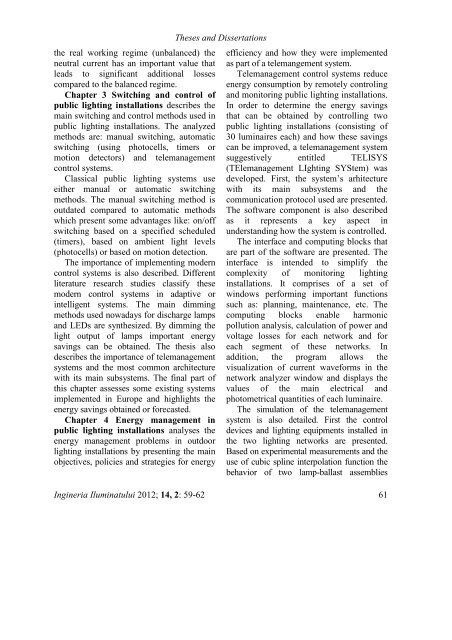Untitled - Journal of Lighting Engineering
Untitled - Journal of Lighting Engineering
Untitled - Journal of Lighting Engineering
Create successful ePaper yourself
Turn your PDF publications into a flip-book with our unique Google optimized e-Paper software.
the real working regime (unbalanced) the<br />
neutral current has an important value that<br />
leads to significant additional losses<br />
compared to the balanced regime.<br />
Chapter 3 Switching and control <strong>of</strong><br />
public lighting installations describes the<br />
main switching and control methods used in<br />
public lighting installations. The analyzed<br />
methods are: manual switching, automatic<br />
switching (using photocells, timers or<br />
motion detectors) and telemanagement<br />
control systems.<br />
Classical public lighting systems use<br />
either manual or automatic switching<br />
methods. The manual switching method is<br />
outdated compared to automatic methods<br />
which present some advantages like: on/<strong>of</strong>f<br />
switching based on a specified scheduled<br />
(timers), based on ambient light levels<br />
(photocells) or based on motion detection.<br />
The importance <strong>of</strong> implementing modern<br />
control systems is also described. Different<br />
literature research studies classify these<br />
modern control systems in adaptive or<br />
intelligent systems. The main dimming<br />
methods used nowadays for discharge lamps<br />
and LEDs are synthesized. By dimming the<br />
light output <strong>of</strong> lamps important energy<br />
savings can be obtained. The thesis also<br />
describes the importance <strong>of</strong> telemanagement<br />
systems and the most common architecture<br />
with its main subsystems. The final part <strong>of</strong><br />
this chapter assesses some existing systems<br />
implemented in Europe and highlights the<br />
energy savings obtained or forecasted.<br />
Chapter 4 Energy management in<br />
public lighting installations analyses the<br />
energy management problems in outdoor<br />
lighting installations by presenting the main<br />
objectives, policies and strategies for energy<br />
Theses and Dissertations<br />
efficiency and how they were implemented<br />
as part <strong>of</strong> a telemangement system.<br />
Telemanagement control systems reduce<br />
energy consumption by remotely controling<br />
and monitoring public lighting installations.<br />
In order to determine the energy savings<br />
that can be obtained by controlling two<br />
public lighting installations (consisting <strong>of</strong><br />
30 luminaires each) and how these savings<br />
can be improved, a telemanagement system<br />
suggestively entitled TELISYS<br />
(TElemanagement LIghting SYStem) was<br />
developed. First, the system’s arhitecture<br />
with its main subsystems and the<br />
communication protocol used are presented.<br />
The s<strong>of</strong>tware component is also described<br />
as it represents a key aspect in<br />
understanding how the system is controlled.<br />
The interface and computing blocks that<br />
are part <strong>of</strong> the s<strong>of</strong>tware are presented. The<br />
interface is intended to simplify the<br />
complexity <strong>of</strong> monitoring lighting<br />
installations. It comprises <strong>of</strong> a set <strong>of</strong><br />
windows performing important functions<br />
such as: planning, maintenance, etc. The<br />
computing blocks enable harmonic<br />
pollution analysis, calculation <strong>of</strong> power and<br />
voltage losses for each network and for<br />
each segment <strong>of</strong> these networks. In<br />
addition, the program allows the<br />
visualization <strong>of</strong> current waveforms in the<br />
network analyzer window and displays the<br />
values <strong>of</strong> the main electrical and<br />
photometrical quantities <strong>of</strong> each luminaire.<br />
The simulation <strong>of</strong> the telemanagement<br />
system is also detailed. First the control<br />
devices and lighting equipments installed in<br />
the two lighting networks are presented.<br />
Based on experimental measurements and the<br />
use <strong>of</strong> cubic spline interpolation function the<br />
behavior <strong>of</strong> two lamp-ballast assemblies<br />
Ingineria Iluminatului 2012; 14, 2: 59-62 61
















